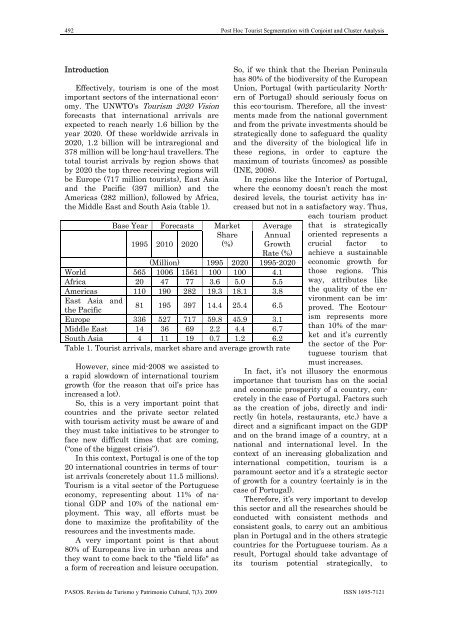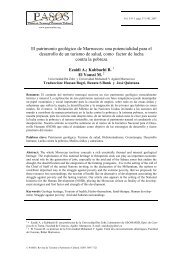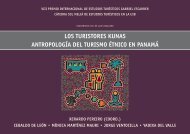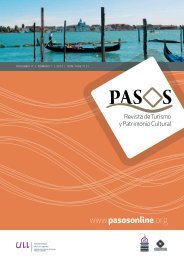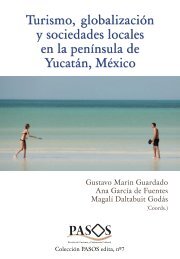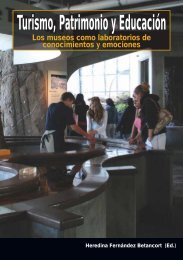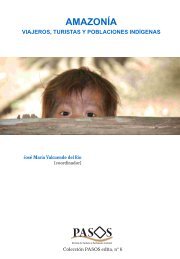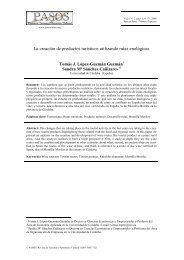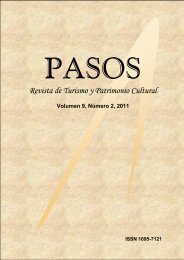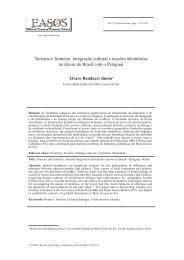Post Hoc Tourist Segmentation with Conjoint and Cluster ... - Pasos
Post Hoc Tourist Segmentation with Conjoint and Cluster ... - Pasos
Post Hoc Tourist Segmentation with Conjoint and Cluster ... - Pasos
You also want an ePaper? Increase the reach of your titles
YUMPU automatically turns print PDFs into web optimized ePapers that Google loves.
492 <strong>Post</strong> <strong>Hoc</strong> <strong>Tourist</strong> <strong>Segmentation</strong> <strong>with</strong> <strong>Conjoint</strong> <strong>and</strong> <strong>Cluster</strong> Analysis<br />
Introduction<br />
Effectively, tourism is one of the most<br />
important sectors of the international economy.<br />
The UNWTO's Tourism 2020 Vision<br />
forecasts that international arrivals are<br />
expected to reach nearly 1.6 billion by the<br />
year 2020. Of these worldwide arrivals in<br />
2020, 1.2 billion will be intraregional <strong>and</strong><br />
378 million will be long-haul travellers. The<br />
total tourist arrivals by region shows that<br />
by 2020 the top three receiving regions will<br />
be Europe (717 million tourists), East Asia<br />
<strong>and</strong> the Pacific (397 million) <strong>and</strong> the<br />
Americas (282 million), followed by Africa,<br />
the Middle East <strong>and</strong> South Asia (table 1).<br />
Base Year Forecasts Market<br />
Share<br />
1995 2010 2020 (%)<br />
However, since mid-2008 we assisted to<br />
a rapid slowdown of international tourism<br />
growth (for the reason that oil’s price has<br />
increased a lot).<br />
So, this is a very important point that<br />
countries <strong>and</strong> the private sector related<br />
<strong>with</strong> tourism activity must be aware of <strong>and</strong><br />
they must take initiatives to be stronger to<br />
face new difficult times that are coming,<br />
(“one of the biggest crisis”).<br />
In this context, Portugal is one of the top<br />
20 international countries in terms of tourist<br />
arrivals (concretely about 11.5 millions).<br />
Tourism is a vital sector of the Portuguese<br />
economy, representing about 11% of national<br />
GDP <strong>and</strong> 10% of the national employment.<br />
This way, all efforts must be<br />
done to maximize the profitability of the<br />
resources <strong>and</strong> the investments made.<br />
A very important point is that about<br />
80% of Europeans live in urban areas <strong>and</strong><br />
they want to come back to the "field life" as<br />
a form of recreation <strong>and</strong> leisure occupation.<br />
So, if we think that the Iberian Peninsula<br />
has 80% of the biodiversity of the European<br />
Union, Portugal (<strong>with</strong> particularity Northern<br />
of Portugal) should seriously focus on<br />
this eco-tourism. Therefore, all the investments<br />
made from the national government<br />
<strong>and</strong> from the private investments should be<br />
strategically done to safeguard the quality<br />
<strong>and</strong> the diversity of the biological life in<br />
these regions, in order to capture the<br />
maximum of tourists (incomes) as possible<br />
(INE, 2008).<br />
In regions like the Interior of Portugal,<br />
where the economy doesn’t reach the most<br />
desired levels, the tourist activity has increased<br />
but not in a satisfactory way. Thus,<br />
Average<br />
Annual<br />
Growth<br />
Rate (%)<br />
(Million) 1995 2020 1995-2020<br />
World 565 1006 1561 100 100 4.1<br />
Africa 20 47 77 3.6 5.0 5.5<br />
Americas 110 190 282 19.3 18.1 3.8<br />
East Asia <strong>and</strong><br />
the Pacific<br />
81 195 397 14.4 25.4 6.5<br />
Europe 336 527 717 59.8 45.9 3.1<br />
Middle East 14 36 69 2.2 4.4 6.7<br />
South Asia 4 11 19 0.7 1.2 6.2<br />
Table 1. <strong>Tourist</strong> arrivals, market share <strong>and</strong> average growth rate<br />
each tourism product<br />
that is strategically<br />
oriented represents a<br />
crucial factor to<br />
achieve a sustainable<br />
economic growth for<br />
those regions. This<br />
way, attributes like<br />
the quality of the environment<br />
can be improved.<br />
The Ecotourism<br />
represents more<br />
than 10% of the market<br />
<strong>and</strong> it’s currently<br />
the sector of the Portuguese<br />
tourism that<br />
must increases.<br />
In fact, it’s not illusory the enormous<br />
importance that tourism has on the social<br />
<strong>and</strong> economic prosperity of a country, concretely<br />
in the case of Portugal. Factors such<br />
as the creation of jobs, directly <strong>and</strong> indirectly<br />
(in hotels, restaurants, etc.) have a<br />
direct <strong>and</strong> a significant impact on the GDP<br />
<strong>and</strong> on the br<strong>and</strong> image of a country, at a<br />
national <strong>and</strong> international level. In the<br />
context of an increasing globalization <strong>and</strong><br />
international competition, tourism is a<br />
paramount sector <strong>and</strong> it’s a strategic sector<br />
of growth for a country (certainly is in the<br />
case of Portugal).<br />
Therefore, it’s very important to develop<br />
this sector <strong>and</strong> all the researches should be<br />
conducted <strong>with</strong> consistent methods <strong>and</strong><br />
consistent goals, to carry out an ambitious<br />
plan in Portugal <strong>and</strong> in the others strategic<br />
countries for the Portuguese tourism. As a<br />
result, Portugal should take advantage of<br />
its tourism potential strategically, to<br />
PASOS. Revista de Turismo y Patrimonio Cultural, 7(3). 2009 ISSN 1695-7121


